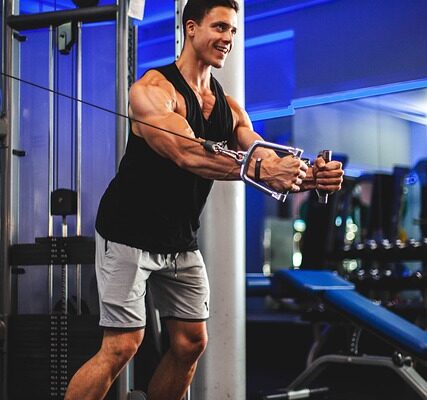The 5 fitness components all contribute to physical fitness and aid in the process of obtaining fit. You are already aware that there are advantages to prioritizing physical activity. The key is to grasp what “fitness” is and how to obtain it.
That’s where the five fitness components come in. They serve as a helpful tool for arranging and performing a well-balanced workout regimen and serve as the model for the American College of Sports Medicine (ACSM) physical activity guidelines.
Developing a fitness plan that integrates these factors might assist in ensuring that you receive the most health advantages out of your workout.
According to the CDC, regular exercise will lower conditions of heart disease and type 2 diabetes, some malignancies, improve bone health, improve mental health, and higher quality of life as one gets older. Learn more about the five fitness components and examples.
Endurance Cardiovascular is one of 5 fitness components
Cardiovascular endurance (also known as aerobic fitness or cardiorespiratory endurance) refers to your body’s ability to efficiently and effectively absorb oxygen and distribute it to your tissues via the heart, lungs, arteries, vessels, and veins. Regular exercise that pushes your heart and lungs allows you to:
- Sustain or improve the efficiency with which oxygen is delivered and absorbed by your body’s systems.
- Improve cellular metabolism
- Reduce the physical demands of daily living
Because heart disease kills over 630,000 people in the United States each year, beginning a workout program that improves cardiovascular fitness is very vital. Running, walking, cycling, swimming, dancing, circuit training, and boxing are some cardiovascular exercises.
Of course, consistency is essential. It may seem like a lot, but 150 minutes is only 20 to 30 minutes of exercise per day, five to seven days a week.
Muscular Endurance is another one of 5 fitness components
One of two aspects that contribute to total muscle health is muscular endurance (muscular strength is the other). Consider muscular endurance to be the ability of a certain muscle group to contract continuously against a given resistance.
Long-distance cycling is a good example. Cycling requires cyclists to develop fatigue-resistant muscles in their legs and glutes in order to pedal a bike over long distances, typically up steep inclines. This demonstrates a high level of muscle endurance.
Holding a plank to increase core strength is another form of isometric training for muscular endurance. The longer you can contract your abdominals and maintain a stable posture, the more endurance you will have in your hips, abs, and shoulders.
Your emphasis on muscle endurance should be directly tied to your health or fitness goals. It’s critical to understand that muscular endurance is group-specific.
This means that depending on your needs, you can acquire high endurance levels in particular muscle groups (such as cyclists developing endurance in their legs) without necessarily getting the same endurance level in other muscle groups.
For Daily Wellness
Talk to a healthcare physician about what is best for you based on your medical history and current fitness level. Everyone has various requirements and goals, so do what is best for you. Some folks may want to build up the endurance to bring groceries from their car to their home. Low-intensity weight-bearing or strength-training routines will aid in the development of endurance.
For Fitness-Related Objectives
Assume you want to be an endurance athlete who can compete in activities that need constant muscle contraction, such as obstacle course racing, CrossFit, or cycling. In that situation, you’ll require more muscular endurance. To become a great athlete, you may want to focus more on training regimens that incorporate high-repetition strength training and sport-specific exercise.
Muscular Power
Muscular endurance relates to how fatigue-resistant a specific muscle group is, whereas muscular strength refers to how much force a specific muscle group can produce in a single, all-out effort. It’s your one-rep max in strength training jargon.
Muscular strength, like muscular endurance, is group-specific. In other words, you could have strong glutes but weak deltoids or powerful pectoral muscles but weak hamstrings.

Consider Your Objectives
Again, how much strength training you do is decided by your health and fitness goals, as well as your physical skills and limitations. Remember that everyone is unique and will have various goals as a result.
Some folks, for example, may desire to be able to move a big box or effortlessly get out of a chair. In this case, increased physical strength may be a consequence of a fitness regimen aimed at increasing muscular endurance.
If you want to gain muscle mass or be able to lift larger weights at the gym, you should devote more time to weight lifting.
It is possible to develop both muscular strength and endurance. This can be done in conjunction with cardiovascular exercise. Circuit-training programs, for example, that mix strength workouts and cardio into a single training session can improve the efficiency of your exercise regimen.
One of Finess Components is Flexibility
The range of motion around a specific joint without pain is referred to as flexibility. Flexibility, like physical strength and endurance, is joint-specific. You may have incredibly flexible shoulders but tight and inflexible hamstrings or hips, for example.
At any age, flexibility is vital. It contributes to free movement and can affect your balance, coordination, and agility. Keeping a full range of motion in your key joints can lower your risk of injury and improve your sports performance.
The value of flexibility grows more evident as you get older. While it is impossible to reverse the aging process entirely, preserving your joints and maintaining mobility can help you stay active far into your golden years.
Ways to Increase Flexibility
There are several simple methods to incorporate flexibility exercises into your daily routine:
- When you are holding a stretch for 10 to 30 seconds is called static stretching.
- Exercises that involve dynamic stretchings, such as barre, yoga, tai chi, or Pilates.
- Active stretching, such as lifting and holding your leg, leverages the opposing muscle’s contraction to relax the muscle being stretched.
- Passive stretching, also known as relaxed stretching, involves assuming a stretch posture and holding it with the help of another portion of your body, a partner, or an object, such as a strap.
- Isometric stretching, a type of static stretching, employs resistance to alternate between muscular relaxation and contraction.
Body Structure
Body composition, or the ratio of fat mass to fat-free mass in your body, is the final component of health-related physical fitness. While excess fat mass has been linked to negative health conditions such as type 2 diabetes and heart disease, most workout regimens aim to achieve and maintain the appropriate body composition for your specific scenario. A healthcare provider can counsel you on what is best for you and your circumstances.
Body Composition Analysis
To see gains in body composition, you must first determine your starting point. Weighing yourself on a scale is not advised because weight alone does not reveal the composition of your interior tissues. Certain body composition measurement methods are more accessible than others.
BIA (bioelectrical impedance analysis): Several gyms offer this form of testing, or you can buy a scale that estimates body fat % using bioelectrical impedance analysis.
Hydrostatic underwater weighing: entails first being weighed on dry land and then on an underwater scale. These testing facilities can be found in research institutes and some fitness establishments.

DEXA (dual-energy X-ray absorptiometry) scans: are commonly used to detect bone mineral density, but they can also correctly estimate body composition. DEXA scans are typically performed at radiology centers and are either covered or not reimbursed by insurance.
Body fat percentage calculator: You can find some calculating programs online. They are not as accurate as a DEXA scan or hydrostatic testing, but they are widely available and simple to use. The readings are normally within three to four percentage points of your real body fat %, so you can use them to track improvements if desired.
To Conclude on 5 Fitness Components
Having these 5 fitness components in mind might help you achieve your fitness objectives. Creating a fitness regimen that involves all of these factors can help you stick to a well-rounded training plan that will improve your health.
It is natural to be drawn to a single aspect of fitness more than others. In order to keep your exercise love alive, you must incorporate parts that are appropriate for your goals and lifestyle.

